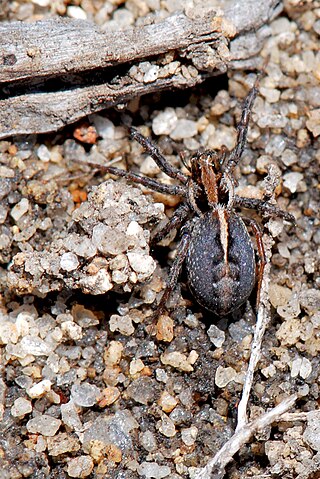
Wolf spiders are members of the family Lycosidae. They are robust and agile hunters with excellent eyesight. They live mostly in solitude, hunt alone, and usually do not spin webs. Some are opportunistic hunters, pouncing upon prey as they find it or chasing it over short distances; others wait for passing prey in or near the mouth of a burrow.

Nursery web spiders (Pisauridae) are a family of araneomorph spiders first described by Eugène Simon in 1890. Females of the family are known for building special nursery webs. When their eggs are about to hatch, a female spider builds a tent-like web, places her egg sac inside, and stands guard outside, hence the family's common name. Like wolf spiders, however, nursery web spiders are roaming hunters that don't use webs for catching prey.

The Artoriinae are a subfamily of wolf spiders. The monophyly of the subfamily has been confirmed in a molecular phylogenetic study, although the relationships among the subfamilies was shown to be less certain.

Artoria is a genus of spiders in the family Lycosidae. It was first described in 1877 by Tamerlan Thorell, and the type species is Artoria parvula. In 1960, Roewer erected the genera Artoriella and Trabeola. However, in 2002, Volker Framenau reviewed Artoria and synonymised both these genera with Artoria.
Artoriellula is a genus of spiders in the family Lycosidae that was first described in 1960 by Roewer.
Auloniella is a genus of spiders in the family Lycosidae. It was first described in 1960 by Roewer. As of 2017, it contains only one species, Auloniella maculisterna, found in Tanzania.
Diahogna is a genus of spiders in the family Lycosidae. It was first described in 1960 by Roewer. As of 2017, it contains 4 Australian species.
Dingosa is a genus of spiders in the family Lycosidae. It was first described in 1955 by Roewer. As of 2017, it contains 6 species from Australia and from South America.
Dolocosa is a genus of spiders in the family Lycosidae. It was first described in 1960 by Roewer. As of 2017, it contains only one species, Dolocosa dolosa, on the island of Saint Helena.
Edenticosa is a genus of spiders in the family Lycosidae. It was first described in 1960 by Roewer. As of 2017, it contains only one species, Edenticosa edentula, on the island of Bioko.

Geolycosa is a genus of wolf spiders first described in 1904.

Hoggicosa is a genus of wolf spiders first described by Carl Friedrich Roewer in 1960. The name is a reference to arachnologist Henry Roughton Hogg.
Hognoides is a genus of spiders in the family Lycosidae. It was first described in 1960 by Roewer. As of 2017, it contains 2 species.
Megarctosa is a genus of spiders in the family Lycosidae. It was first described in 1948 by Caporiacco. As of 2017, it contains 7 species.
Molitorosa is a genus of spiders in the family Lycosidae. It was first described in 1960 by Roewer. As of 2017, it contains only one Brazilian species, Molitorosa molitor.
Mustelicosa is a genus of spiders in the family Lycosidae. It was first described in 1960 by Roewer. As of 2017, it contains 2 species.
Paratrochosina is a genus of spiders in the family Lycosidae. It was first described in 1960 by Roewer. As of 2017, it contains 3 species.

Tetralycosa is a genus of Australian spiders in the family Lycosidae first described by Roewer in 1960, later revised by Framenau & Hudson to include thirteen species. Genetic studies show that these spiders all diverged from a common ancestor who likely wandered into the salty area and remained. They live exclusively in certain saline environments of Australia's interior, including coastal beaches, mound springs, clay pans, and salt lakes. There haven't been enough studies to establish a conservation status, but some species have only been found in solitary salt lakes, suggesting that the increase of mining, agriculture, recreational, and similar disturbances of these unique ecosystems may eventually lead to their extinction if not properly regulated.
Anomalosa oz is a spider in the Lycosidae family. It was first described in 2006 by Volker Framenau.
Anomalosa kochi is a spider in the Lycosidae family. It was first described in 1898 by Eugène Simon as Anomalomma kochi. In 1960, it was transferred to the genus Anomalosa by Carl Friedrich Roewer. The current description is given by Volker Framenau.






